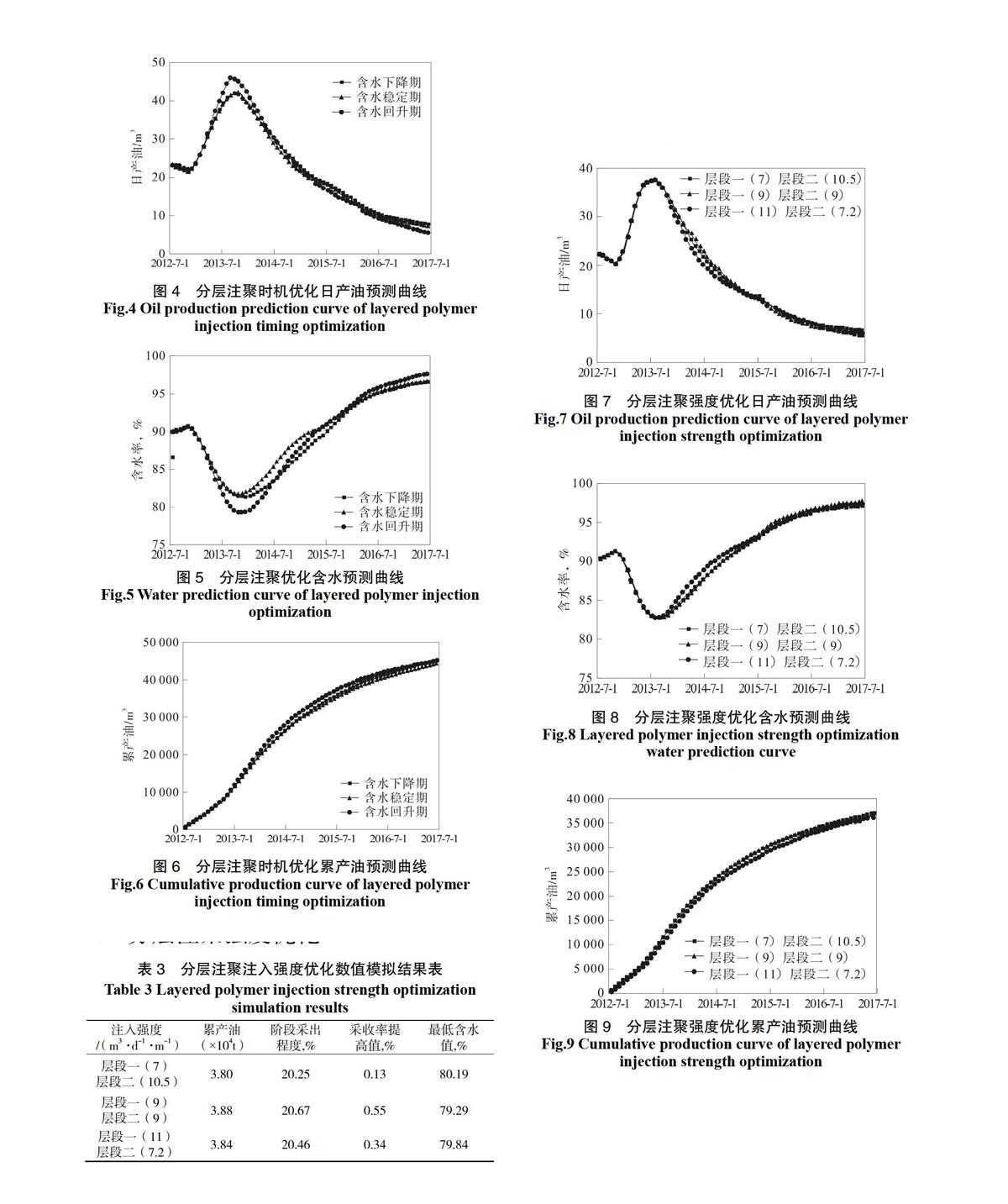二類油藏分層注聚措施優選
萬榮暉



摘 要:薩南開發區油藏屬普通稠油油藏,油層存在油層厚度小、連通狀況差、層間矛盾大等特點。若采用籠統注聚,非主力油層受層間干擾的影響,吸聚量少,對油井見效晚,開發效果差。因此采用分層注聚技術,使聚合物驅注聚剖面得到有效改善,從而解決主力油層與非主力油層間吸聚量差異大的問題,實現層間合理配注,延長注聚區的有效期,進而提高階段采收率。采用ECLIPSE軟件模擬分層注聚,并給出分層聚驅措施優化,包括分層措施時機優化和分層注聚強度優化,使分層注聚效果達到最優。
關 鍵 詞:稠油油藏;聚驅;分層注聚;措施優化
中圖分類號:TE 122 文獻標識碼: A 文章編號: 1671-0460(2015)07-1531-03
Optimization of Separate-layer
Polymer Injection Measures for TypeⅡReservoirs
WAN Rong-hui
(Northeast Petroleum University, Heilongjiang Daqing 163000, China)
Abstract: Reservoir in Sanan development area is a common heavy oil reservoir; the reservoir has the characteristics of small reservoir thickness, poor connectivity, and big interlayer contradiction and so on. If using the general injection process, because the non-main layer is affected by interlayer interferenc, its absorbing polymer amount is less, so development effect is poor. The separate-layer polymer injection technology can improve the injection profile of polymer flooding, and solve the problem of large absorbing amount difference between main and non-main layers to achieve interlayer reasonable match injection and extend the period of validity of polymer injection region to improve the recovery rate. In this paper, ECLIPSE software was used to simulate the separate-layer polymer injection, and the measures to optimize the stratification of polymer flooding were put forward to achieve the optimal effect of separate-layer polymer injection, including hierarchical measure time and hierarchical injection strength optimization.
Key words: Heavy oil reservoir; Polymer flooding; Separate-layer polymer injection; Optimization measures
聚驅措施優化包括分層、解堵、壓裂以及分微相注聚,本文將著重分析分層聚驅措施優化。同水驅采油一樣,聚合物驅采油也存在層間矛盾,若采用籠統注聚開采方式,聚合物溶液將主要進入主力油層,因此會對油井見效早;而非主力油層,因受層間干擾的影響,吸聚量少,對油井見效晚,注聚開采效果差。分層注聚能有效改善注聚剖面,使聚合物溶液沿高滲層突進現象得到控制,并解決主力油層與非主力油層吸聚量差異大的問題,使非主力油層得到有效開發,實現層間合理配注,延長注聚區的有效期,可進一步提高采收率[1-5]。
1 試驗區地質概況及開發現狀
薩南開發區油藏屬普通稠油油藏,油層表現為油層厚度小、連通狀況差、層間矛盾大等特點。試驗區控制面積0.24 km2,孔隙體積39.88×104 m3,地質儲量18.77×104 t。中心井區控制面積0.06 km2,孔隙體積9.53×104 m3,地質儲量4.59×104 t。試驗區葡I5-7、葡II1-3油層縱向上可分6個小層、8個沉積單元。水驅結束后,試驗區累產油7.37×104 t,采出程度為39.28%,剩余含油飽和度為50.82%,圖1為各層剩余油分布。
南三區中塊試驗區目的層綜合含水率達87.24%,處于高含水期開采階段。葡I5-7~葡II1-3油層有效厚度水淹比例較高,繼續水驅挖潛的難度越來越大,水驅開發的經濟效益較差。因此有必要轉聚驅并進行聚驅注入參數優化研究,改善二類油層開發效果。
圖1 各層剩余油分布圖
Fig.1 Distribution of remaining oil in each layer
2 分層措施
對試驗區進行兩組模擬研究,一組是籠統注聚,一組是分層注聚(將聚合物驅目的層分為PI5+61a-PI7和PII1a-PII3兩段)。
不分層方案采取清配清稀最優方案(聚合物分子量950~1 200萬,濃度1 100 mg/L,注入速度0.2 PV/a,注入段塞0.64 PV),分層方案為層段一、二的注聚強度均為9 m3/(d·m),分層注聚時機為含水穩定期,模擬結果如表1所示。
圖2、圖3是分層與不分層含水對比以及累產油對比。數值模擬結果表明:分層注聚后,全區含水略有下降,含水穩定期延長,累產油增產0.103×104 t,階段采收率比不分層提高0.55%,因此分層注聚效果比不分層好。
3 分層措施時機優化
根據近幾年在注入井分層注入方面的做法,以及油層性質與發育狀況,將目標層段分為兩層,PI5+61a-PI7為層段一,PII1a-PII3為層段二。分別選擇含水下降期分層、含水穩定期分層、含水回升期分層三種方案進行模擬計算。同時也考慮對空白水驅進行分層注聚,層段一、二的注聚強度均為9 m3/(d·m)。分層注聚時機優化數值模擬結果如表2所示。
圖2 全區含水對比
Fig.2 The region's moisture contrast
圖3 全區累產油對比
Fig.3 The region's cumulative oil contrast
表1 注聚措施方案模擬結果
Table 1 Simulation results of the scheme for polymerization injection
時間 不分層 分層 差值
累產油(×104t) 累產油(×104t) 累產油(×104t)
2012 0.407 0.419 0.011
2013 1.603 1.614 0.011
2014 2.602 2.671 0.069
2015 3.187 3.287 0.099
2016 3.557 3.660 0.103
2017 3.777 3.880 0.103
表2 分層注聚時機優化模擬結果
Table 2 Layered polymer injection timing optimization simulation results
分層注聚
時機 累產油
(×104t) 階段采出程度,% 采收率提高值,% 最低含水值,%
含水下降期 3.88 20.67 0.55 79.29
含水穩定期 3.85 20.51 0.39 81.37
含水回升期 3.79 20.19 0.07 81.62
圖4是分層注聚時機優化日產油對比曲線,圖5是分層注聚時機優化含水對比曲線,圖6是分層注聚時機優化累產油對比曲線。數值模擬結果表明:
注入井在含水下降期、含水穩定期、含水回升期實施分層注聚,比不分層注聚采收程度分別提高0.55%、0.39%、0.07%。同時,在含水下降期進行分層注聚開發效果最好,因此分層注聚越早越好。
圖4 分層注聚時機優化日產油預測曲線
Fig.4 Oil production prediction curve of layered polymer injection timing optimization
圖5 分層注聚優化含水預測曲線
Fig.5 Water prediction curve of layered polymer injection optimization
圖6 分層注聚時機優化累產油預測曲線
Fig.6 Cumulative production curve of layered polymer injection timing optimization
4 分層注聚強度優化
表3 分層注聚注入強度優化數值模擬結果表
Table 3 Layered polymer injection strength optimization simulation results
注入強度
/(m3·d-1·m-1) 累產油
(×104t) 階段采出程度,% 采收率提高值,% 最低含水值,%
層段一(7)
層段二(10.5) 3.80 20.25 0.13 80.19
層段一(9)
層段二(9) 3.88 20.67 0.55 79.29
層段一(11)
層段二(7.2) 3.84 20.46 0.34 79.84
在含水下降期進行分層注聚的基礎上,改變層段一、層段二的注聚強度,進行分層注聚注入強度優化數值模擬,結果如表3所示。
另外,圖7是分層注聚強度優化日產油對比曲線,圖8是分層注聚強度優化含水對比曲線,圖9是分層注聚強度優化累產油對比曲線。
圖7 分層注聚強度優化日產油預測曲線
Fig.7 Oil production prediction curve of layered polymer injection strength optimization
圖8 分層注聚強度優化含水預測曲線
Fig.8 Layered polymer injection strength optimization water prediction curve
圖9 分層注聚強度優化累產油預測曲線
Fig.9 Cumulative production curve of layered polymer injection strength optimization
從上述數值模擬結果可以看出:分層注聚強度層段一、層段二均為9 m3/(d·m)比未分層注聚提高0.55%,最低含水值為79.29%。 (下轉第1537頁)

